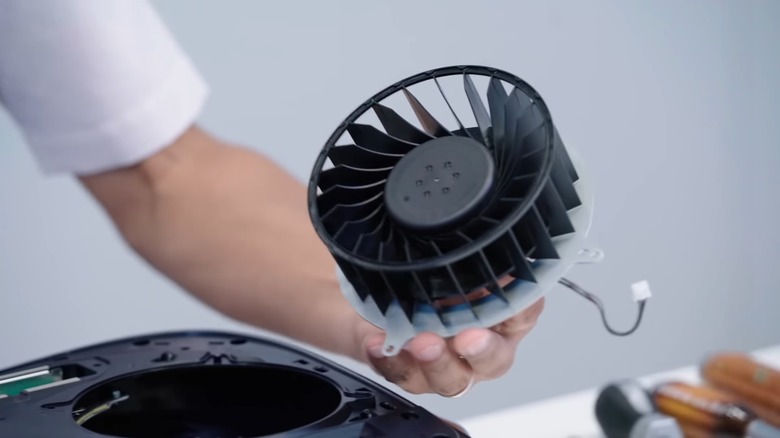Sony Isn't Done Optimizing The PS5
On Oct. 7, Sony posted an in-depth video and blog post that gave audiences a sneak peak into what hides under the PlayStation 5's hood. The video and accompanying blog might demonstrate what makes the PS5 tick, but audiences have learned that both the PS5 and Xbox Series X will not be one-and-done devices. Gamers can upgrade their consoles with expanded (and expensive) external SSDs, for example. More importantly, Sony will provide the occasional update to keep the PlayStation 5 cool under pressure.
Recently, the Japanese site 4Gamer.net sat down with the VP of Sony's mechanical design department, Yasuhiro Ootori (i.e., the guy who took apart the PS5 in the video), and ResetEra user orzkare provided some handy translations. The interview focused on the PS5 and its internal hardware, but of particular note was how the console will stay cool, both initially and as time goes on.
According to Ootori, cooling priority starts and ends with the console's Accelerated Processing Unit, or APU for short. This hybrid CPU and GPU must remain chilled to squeeze as much power as possible out of the console. To maintain a consistent and comfortable operating temperature, the PS5 will come with four temperature sensors. One sensor will be mounted inside the APU, while the others will be strategically placed around the PS5's board. These sensors will work in tandem with the console's fan — whichever sensor records the highest temperature will dictate the fan's speed. These sensors will also influence future PS5 updates.
Ootori claimed the sensors will gather and record APU temperature and performance data, and then send the data to Sony. After the data is examined, Sony can (and will) provide online updates/patches to optimize fan speeds, especially for future games that force the APU to experience heavy loads for long periods of time. While the PS5's fan is supposed to be softer than that of the PS4 — which many gamers compare to a jet engine at takeoff when at full blast — these updates could sacrifice a quiet play environment to provide higher fan speeds and increased cooling.
However, even though Sony plans to improve the PS5's fan performance through future updates, the company is not taking a "fix it later" approach to console ventilation. In the interview, Ootori stated Sony spent over two years developing the PS5's cooling system. The company experimented with heat sinks and liquid metal cooling solutions — a risky proposal since liquid metal is as efficient at drawing away heat as it is dangerously caustic. If the material leaks onto the PS5's board, the console will short circuit and turn into a $500 paperweight. Meanwhile, if liquid metal leaks into the heat sink, it will eat away at the component's aluminum material, reducing the heat sink's ability to effectively ferry heat away from the PS5's internal hardware.
Moreover, Sony conducted real-world experiments to ensure the PS5's airflow keeps the console as cold as possible. The company built translucent console chassis, filled them with dry ice smoke, and observed how the smoke ran through the console, all while taking temperature readings. If the team found problems, it made improvements where necessary.
Sony took every precaution to keep the PS5 as cool and safe as possible, but once you design and manufacture a heat sink — or a liquid metal cooling solution — you can't improve upon them without taking the console apart and installing new components. The console's oversized fan can be set to run at different speeds to pick up the cooling pace, and the PS5's shape and size was designed around the extra-large cooling fan and heat sink. It is common knowledge that the Xbox Series X is a monolith of a console, and according to Ootori, the PS5 is even larger than the Series X, albeit not by much. To fit the processing and cooling components into the console, the PS5 is approximately 1.05 times as massive as the Series X. Meanwhile, the Digital Edition is 0.93 times as big since it lacks a disc drive.
Many gamers might not like the prospect of letting console manufacturers peek at data collected from their devices — especially after the recent PlayStation 4 update that records voice chat. However, actively monitoring PS5 temperature and fan performance metrics for later use should keep the console as cool as possible in the foreseeable future, especially as game developers draw more and more power from the APU. After Microsoft had its own mini-controversy with heat (though that's since been debunked), the more Sony does to allay PS5 overheating problems and fears, the better.

